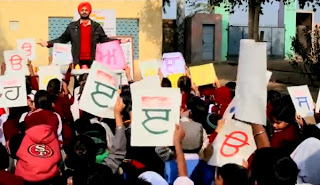Ludhiana-based theatre veteran Nirmal Rishi has been honoured with the prestigious 2012 Sangeet Natak Akademi award for acting.
The award, presented to a total of 36 artists for the year in music, dance and theatre from all over the country, is the highest Indian recognition given to practicing artists.
An elated Rishi says she feels blessed as her efforts of spreading social messages through have been recognized.
The award, comprising a cash prize of Rs 1 lakh, a taam patra and a shawl, was presented by President Pranab Mukherjee at a ceremony in Rashtrapati Bhawan on May 28.
With a theatre career spanning almost half a century, 70-year-old Rishi has acted in around 50 plays.
“That was a golden time when Punjab had a flourishing theatre scene. We put up several amazing plays such as Kabuli Wala, Aate Ki Katori, Dug Dugi Payi Wajdi, Adhure Sapne and Chamkaur di Garri,” recalls the artist, who even appeared in a few films including Laung da Lashkara.
Born in Mansa, Rishi completed her higher education from Ganga Nagar, Rajasthan. It was in college that she began performing on stage.
She moved to Ludhiana for work and took up a job of a lecturer of Physical Education at Khalsa College for Women, Civil Lines. She retired after a service of 34 years.
While she always pursued theatre on the side, traveling frequently to other parts in Punjab and even abroad in Canada, US and the UK, it was after her retirement that Rishi formed a theatre group in 2003 named Alive Artists.
 Rishi acts, writes scripts for the play and, lately, has even taken up the role of a director. “I have directed around five-six plays so far. Direction has caught my fancy and this is what I focus on now,” she says.
Rishi acts, writes scripts for the play and, lately, has even taken up the role of a director. “I have directed around five-six plays so far. Direction has caught my fancy and this is what I focus on now,” she says.
She, along with her 15-member team, performed at Rashtrapati Bhawan after the award ceremony.
Rishi has never married, and lives in Gurdev Nagar resident.
The award, presented to a total of 36 artists for the year in music, dance and theatre from all over the country, is the highest Indian recognition given to practicing artists.
An elated Rishi says she feels blessed as her efforts of spreading social messages through have been recognized.
The award, comprising a cash prize of Rs 1 lakh, a taam patra and a shawl, was presented by President Pranab Mukherjee at a ceremony in Rashtrapati Bhawan on May 28.
With a theatre career spanning almost half a century, 70-year-old Rishi has acted in around 50 plays.
Spotted by Punjab’s theatre veterans Harpal and Neena Tiwana and further groomed by greats such as Ebrahim Alkazi and Balwant Gargi, Rishi has dedicated her life to the art that she feels the society must embrace for its betterment.
“That was a golden time when Punjab had a flourishing theatre scene. We put up several amazing plays such as Kabuli Wala, Aate Ki Katori, Dug Dugi Payi Wajdi, Adhure Sapne and Chamkaur di Garri,” recalls the artist, who even appeared in a few films including Laung da Lashkara.
Born in Mansa, Rishi completed her higher education from Ganga Nagar, Rajasthan. It was in college that she began performing on stage.
She moved to Ludhiana for work and took up a job of a lecturer of Physical Education at Khalsa College for Women, Civil Lines. She retired after a service of 34 years.
While she always pursued theatre on the side, traveling frequently to other parts in Punjab and even abroad in Canada, US and the UK, it was after her retirement that Rishi formed a theatre group in 2003 named Alive Artists.
 Rishi acts, writes scripts for the play and, lately, has even taken up the role of a director. “I have directed around five-six plays so far. Direction has caught my fancy and this is what I focus on now,” she says.
Rishi acts, writes scripts for the play and, lately, has even taken up the role of a director. “I have directed around five-six plays so far. Direction has caught my fancy and this is what I focus on now,” she says.She, along with her 15-member team, performed at Rashtrapati Bhawan after the award ceremony.
Rishi has never married, and lives in Gurdev Nagar resident.





























